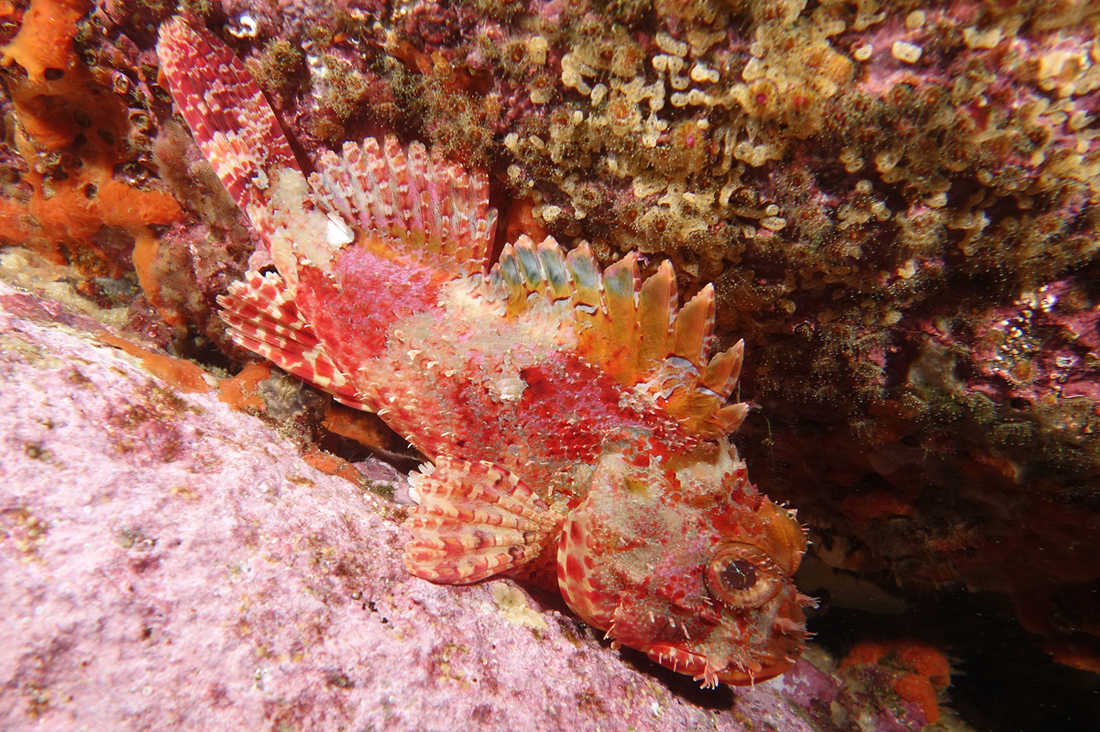- Classification
- ACTINOPTERYGII
- SCORPAENIFORMES
- SCORPAENIDAE
- Scorpaena
- jacksoniensis
Eastern Red Scorpionfish, Scorpaena jacksoniensis Steindachner 1866

An Eastern Red Scorpionfish, Scorpaena jacksoniensis, at North Head, Sydney Harbour, New South Wales, 18 March 2016. Source: John Turnbull / Flickr. License: CC by Attribution-NonCommercial-ShareAlike
Although named the Eastern Red Scorpionfish, this common species is variable in colour, ranging from bright red to a pale greyish-brown, with darker and lighter blotches and mottling. Juveniles may have a white to purplish blotch across the back of their head. The dorsal-fin spines have a venom gland at the base, and a sting from this species may be excruciatingly painful.
Video of an Eastern Red Scorpionfish
Until recently, this species was called Scorpaena cardinalis, a species that was described from New Zealand. Motomura et al. (2011) showed that S. cardinalis is only found around islands in the Tasman Sea (including Lord Howe Island and Norfolk Island) and New Zealand, and does not occur in the waters of mainland Australia.
Eastern Red Scorpionfish, Scorpaena jacksoniensis Steindachner 1866
More Info
|
Distribution |
Endemic to temperate waters of south-eastern Australia from off Caloundra, Queensland, to Beware Reef, Victoria, and possibly further west to Western Port, Victoria. The Eastern Red Scorpionfish commonly inhabits shallow estuaries to deeper offshore reefs in depths to 73 m. It is common on coastal reefs in New South Wales. The Victorian records are based on few specimens collected respectively in "Victoria" in 1890 and in "Western Port" in 1930; otherwise the species is only known south to Jervis Bay (New South Wales). |
|
Features |
Dorsal fin spines/rays XII, 9; Pectoral fin rays 16-18; Gill rakers 4-6 + 10-13 = 14-19; Lateral line scales (pored) 22-24. Most scorpionfishes are ambush predators and skin flaps and their colour pattern provide excellent camouflage. |
|
Size |
To at least 40 cm. |
|
Feeding |
The Eastern Red Scorpionfish is an well-camouflaged ambush predator. It lies motionless on the bottom, moving only when disturbed, and waiting for unwary fishes and crustaceans to come within striking distance of its large mouth. Prey items are swallowed whole. |
|
Biology |
The sexes are separate and fertilisation is external. Stewart & Hughes (2010) found that the species breeds during summer and autumn. Females produce hollow, bilobed gelatinous egg masses that provide protection and floatation for the eggs and developing embryos. Eastern Red Scorpionfish are slow-growing, with individuals reaching 22 cm after 5 years and 26 cm after 10 years. The oldest fish sampled was estimated to be 33 years old. See Stewart & Hughes (2010) for further information on age, growth and reproduction. |
|
Fisheries |
Off minor commercial and recreational importance. The species is taken by commercial line fishers and offshore recreational fishers (Steffe et al.1996). The flesh is white and considered excellent eating. |
|
Conservation |
|
|
Remarks |
Motomura et al. (2011) revised the group and determined that Scorpaena jacksoniensis is a valid species, and is what had previously been referred to as Scorpaena cardinalis in eastern Australia. Scorpaena cardinalis is found at Lord Howe Island in the Tasman Sea, northern New Zealand and the Kermadec Islands. |
|
Etymology |
The species is named after Port Jackson, the type locality. |
|
Species Citation |
Scorpaena jacksoniensis Steindachner 1866, Anzeiger der Kaiserlichen Akademie der Wissenschaften, Mathematisch-Naturwissenschaftlichen Classe 3(7): 50. Type locality: Port Jackson, NSW. |
|
Author |
Bray, D.J. 2018 |
|
Resources |
Eastern Red Scorpionfish, Scorpaena jacksoniensis Steindachner 1866
References
Coleman, N. 1980. Australian Sea Fishes South of 30ºS. Lane Cove, NSW : Doubleday Australia Pty Ltd 309 pp. (as Scorpaena cardinalis)
Edmonds, C. 1978. Dangerous Marine Animals of the Indo-Pacific Region, (Diving Centre Monograph on identification first aid and medical treatment). Wedneil Publications. 235 pp. (as Scorpaena cardinalis)
Grant, E.M. 1975. Guide to Fishes. Brisbane : Queensland Government, Co-ordinator General’s Department 640 pp. (as Scorpaena cardinalis)
Hutchins, J.B. & Swainston, R. 1986. Sea Fishes of Southern Australia. Complete field guide for anglers and divers. Perth : Swainston Publishing 180 pp. (as Scorpaena cardinalis)
Johnson, J.W. 1999. Annotated checklist of the fishes of Moreton Bay, Queensland, Australia. Memoirs of the Queensland Museum 43(2): 709-762 (as Scorpaena cardinalis)
Johnson, J.W. 2010. Fishes of the Moreton Bay Marine Park and adjacent continental shelf waters, Queensland, Australia. pp. 299-353 in Davie, P.J.F. & Phillips, J.A. Proceedings of the Thirteenth International Marine Biological Workshop, The Marine Fauna and Flora of Moreton Bay. Memoirs of the Queensland Museum 54(3) (as Scorpaena cardinalis)
Kuiter, R.H. 1993. Coastal Fishes of South-Eastern Australia. Crawford House Press. 437 pp. (as Scorpaena cardinalis)
Kuiter, R.H. 1996. Guide to Sea Fishes of Australia. New Holland. 433 pp. (as Scorpaena cardinalis)
Motomura, H., C.D. Struthers, M.A. McGrouther & A.L. Stewart. 2011. Validity of Scorpaena jacksoniensis and a redescription of S. cardinalis, a senior synonym of S. cookii (Scorpaeniformes: Scorpaenidae). Ichthyological Research 58: 315–332, figs 1-11
Ogilby, J.D. 1893. Edible Fishes and Crustaceans of New South Wales. Sydney : Government Printer 212 pp. 51 pls. (as Scorpaena cruenta)
Poss, S.G. 1999. Families Scorpaenidae, Caracanthidae, Aploactinidae. pp. 2291-2358 in Carpenter, K.E. & Niem, T.H. (eds). The Living Marine Resources of the Western Central Pacific. FAO Species Identification Guide for Fisheries Purposes. Rome : FAO Vol. 4 2069-2790 pp. (as Scorpaena cardinalis)
Stead, D.G. 1908. The Edible Fishes of New South Wales: their present importance and their potentialities. Sydney : N.S.W. Government 124 pp. 81 pls. (as Scorpaena cruenta)
Steindachner, F. 1866. Über die Fische von Port Jackson in Australien. Anzeiger der Kaiserlichen Akademie der Wissenschaften. Mathematisch-Naturwissenschaftliche Klasse, Wien 3(7): 50-55.
Stewart, J. & Hughes, J.M. 2010. Life-history traits of the southern hemisphere eastern red scorpionfish, (Scorpaenidae: Scorpaeninae). Marine & Freshwater Research 61: 1290–1297 (as Scorpaena cardinalis) PDF
Whitley, G.P. 1931. New names for Australian fishes. The Australian Zoologist 6(4): 310-334 1 fig. pls 25-27 (as Ruboralga jacksoniensis)
Yearsley, G.K., Last, P.R. & Ward, R.D. (eds) 1999. Australian Seafood Handbook. Hobart : CSIRO Marine Research 460 pp.










